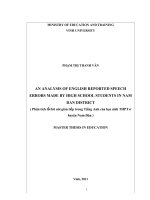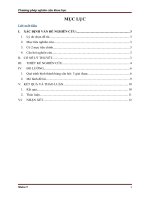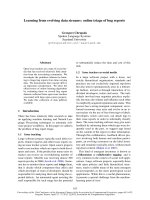Principle of management report
Bạn đang xem bản rút gọn của tài liệu. Xem và tải ngay bản đầy đủ của tài liệu tại đây (152.36 KB, 17 trang )
TABLE OF CONTENTS
Contents
Page
Introduction..............................................................................................2
Theorytical framework on Leadership.....................................................3
1. Leading/Leadership.............................................................................3
2. Leader..................................................................................................3
Power...................................................................................................3
Traits....................................................................................................4
3. Behavioral approaches.........................................................................5
Studies of Iwoa university...................................................................5
Studies of Michigan university............................................................9
Managerial grid.....................................................................................9
Situational approaches..........................................................................10
Findings and analysis on Leadership.........................................................10
1. Summarizing the content of video........................................................10
2. Findings and analysis the video............................................................11
Recommendation........................................................................................13
1. About leadership powers.......................................................................13
2. About the three-style model of Kurt Lewin......................................14
Conclusion............................................................................................16
References.............................................................................................17
1
INTRODUCTION
We are living in the world where change is happening quickly in every aspect:
Management has changed the way many organizations conduct business activities; the
development of information technology has changed traditional concepts about
organization and workspace; The rise of service organizations has changed the
structure of the economy. These changes made things that only a short time ago were
considered the principles or template for success, now they are no longer suitable for
modern management. To succeed, today's and future managers should have the
management capabilities to adapt to the demands of the times.
Managers must understand clearly about management, which is a process of working
with and through other people to achieve the goals. Management has many different
functions, and each function plays a certain important role. One of those functions is
Leading. Leadership is always considered as an indispensable factor for any business
regardless of size. By the leader is like a captain, who leads the company boat to
overcome challenges to achieve the goals.
In this report, our group will emphasize Leadership theories and show our findings
and analysis on Leadership and recommendation for managerial decisions.
2
I.
THEORETICAL FRAMEWORK ON LEADERSHIP
1. LEADING/ LEADERSHIP
Leading/ Leadership is a process of influencing other people to act positively to
accomplish specified goals.
2. LEADER
Leader is a person who directs his/her followers toward a common objective,
plays roles (such as coaching, supporting, training, and instructing employees).
Also, his/her jobs related to improving relationships between leaders and
followers, and among followers, and building a positive working environment.
2.1 POWERS
Leadership Power
Coercive
Power
Legitimate
Power
Reward Power
Expert Power
Referent Power
2.1.1 COERCIVE POWER
This is the power a leader has to punish or control. Followers react to this
power out of fear of the negative results that might occur if they don’t
comply. Managers typically have some coercive power, such as being able
to suspend or demote employees or to assign them work find unpleasant or
undersirable.
2.1.2 REWAD POWER
This is the power to give positive rewards. A reward can be anyting that a
person values such as money, favorable perormance appraisals, promotions,
interesting work assignments, friendly colleagues, and preferred work shifts
or sales territories.
2.1.3 LEGITIMATE POWER
Legitimate power and authority are the same. Legitimate power represents
the power a leader has as a result of his or her position in the organization.
3
Although people in positions of authority are also likely to have reward and
coercive power, legitimate power is broader than the power to coerce and
reward.
2.1.4 EXPERT POWER
As the title says, a leader has expert power when the followers believe that
the leader has “expert” knowledge or skills that are relevant to the job or
tasks they have to complete. Experienced members or staff of the
organization can earn this power and be leaders even though they are
neither supervisors nor managers of followers.
2.1.5 REFERENT POWER
This power is created when the followers believe that the leader possess
good qualities making employees admire and would like to be good as the
leader. As referent power is depend on how the follower views the leader’s
pros, the leader will not have the same referent power over every follower.
2.2 TRAITS
EXTRA
VISION
EXTRAVISION
DRIVE
DRIVE
JOB-RELEVANT
KNOWLEDGE
KNOWLEDGE
DESIRE
DESIRE TO
TO LEAD
LEAD
INTELLIGENCE
INTELLIGENCE
HONESTY
AND INTEGRITY
HONESTY AND
INTEGRITY
SELF-CONFIDENCE
SELF-CONFIDENCE
DRIVE: Leaders exhibit a high effort level. They have a relatively high
desire for achievement, they are ambitious, they have a lot of energy, they are
tirelessly persistent in their activities, and they show initiative.
4
DESIRE TO LEAD: Leaders have a strong desire to influence and lead
others. They demonstrate the willingness to take responsibility.
HONESTY AND INTEGRITY: Leaders build trusting relationships with
followers by being truthful or non-deceitful and by showing high consistency
between word and deed.
SELF-CONFIDENCE: Followers look to leaders for an absence of selfdoubt. Leaders, therefore, need to show self-confidence in order to convince
followers of the rightness of their goals and decisions.
INTELLIGENCE: Leaders need to be intelligent enough to gather,
synthesize, and interpret large amounts of information, and they need to be able
to create visions, solve problems, and make correct decisions.
JOB-RELEVANT KNOWLEDGE: Effective leaders have a high degree
of knowledge about the company, industry, and technical matters. In-depth
knowledge allows leaders to make well-informed decisions and to understand
the implications of those decisions.
EXTRAVERSION: Leaders are energetic, lively people. They are
sociable, assertive, and rarely silent or withdrawn.
3. BEHAVIORAL APPROACH
3.1 STUDIES OF IOWA UNIVERSITY (KURT LEWIN)
Authoritarian
Participative
Leadership
Leadership
Delegative
Leadership
Lewin's Leadership Styles Framework
(Pair right leader style with right situation)
OVERVIEWING THE THREE-STYLE MODEL
AUTOCRATIC
DEMOCRATIC LAISSEZ-FAIRE
5
Make
Individual
decision
(Leader)
Use power
Centralized
(Leader)
Supervise
Strictly/Tightly
followers
(Leader)
Require
followers
Employees
obey/listen/follo
w
Collective
(Leaders and
Employees themselves
Employees)
Decentralized
(Leaders and
Employees empowered
Employees)
Feedback
Outcomes
(Employees)
Participation
Employees being
Discussion
creative/responsible/active
3.1.1. AUTOCRATIC LEADERSHIP
Autocratic leadership is a style, where leaders have a lot of power over their
people. Everyone but the leader has little opportunity to make any
suggestion. The leader does not consult employees, nor are they allowed to
give any input. Authoritarian leader usually determines the specific task for
each participant because they often believe that their employees are lack of
abilities and need strict guidance and control. Thus, it is rigid and
inflexible.
Such leader tends to discourage team’s members, who might resign
themselves to fact that the leader will make all of the decisions no matter
what others have to contribute. Leaders who apply the authoritarian style
may very quickly reach the solution they want, but in terms of group
morale, the costs are high. In many circumstances, the leaders want his/her
group to know beyond any doubt that they are in control. The leaders are
unaware and unconcerned about how people think they are.
In contrast, authoritarian leaders would be appropriate in some situations,
for instance, in a crisis or when time is extremely limited or when the
matter under discussion is trivial. In the field of military, leaders often use
6
an autocratic leadership style; top commanders are responsible for quickly
making complex decisions, which allows troops to focus their attentions
and energies on performing their allotted tasks and missions.
Advantages of this style: Incredibly efficiency; Decisions are made quickly
and work gets done efficiently.
Disadvantages of this style: High levels of absenteeism and high staff
turnover can occur.
3.1.2. DEMOCRATIC LEADERSHIP
Participative leadership, also known as democratic leadership, is a type of
leadership style in which members of the group take a more participative
role in the decision-making process.
Everyone is given the opportunity to participate, ideas are exchange freely,
and discussion is encouraged. While the democratic process tends to focus
on group equality and the free flow of ideas, the lead of the group is still
there to offer guidance and control. The democratic leader is charged with
deciding who is in the group and who gets to contribute to the decisions
that are made.
Some of the primary characteristics of participative leadership include:
Group members are encouraged to share ideas and opinions, even though
the leader retains the final say over decisions; Members of the group feel
more engaged in the process; Creativity is encouraged and rewarded.
Strong participative leaders inspire trust among followers. They are sincere
and base their decisions on their morals and values. Followers tend to feel
inspired to take action and contribute to the group. Good leaders also tend
to seek out diverse opinions and do not try to silence dissenting voices or
those that offer a less popular point of view.
Advantages of this style: Team members tend to have high job satisfaction
and are productive. This style also helps develop people’s skills. Team
7
members feel in control of their destiny, so they are motivated to work hard
by more than just a financial reward.
Disadvantages of this style: It can often hinder situations where speed or
efficiency is essential. For example, during a crisis, a team can waste
valuable time gathering people’s input. Some team members might not
have the knowledge or expertise to provide high quality inputs.
3.1.3. LAISSEZ-FAIRE LEADERSHIP
This French phrase means “freedom” or “leave it be”, and it describes
leaders who allow their people to work on their own. This type of
leadership can also occur naturally, when managers do not have sufficient
control over their work and their people. Laissez-faire leaders may give
their teams complete freedom to do their work and set their own deadlines.
They provide team support with resources and advices, if needed, but
otherwise do not get involved. The laissez-faire leadership style is also
known as the “hands-off” style. All authority or power is given to the
employees and they must determine goals, make decisions, and resolve
problems on their own. The leader of a laissez-faire gathering always tries
to view the discussion from the frame of reference of the member who is
speaking.
Advantages: Giving team members so much autonomy can lead to high job
satisfaction and helping to increase productivity.
Disadvantages: Team members do not manage their time well. If they do
not have knowledge, skills, or motivations, they will not do their work
effectively.
3.2.
STUDIES OF MICHIGAN UNIVERSITY
The focus of the Michigan studies was to determine the principles and
methods of leadership that led to productivity and job satisfaction. The
studies resulted in two general leadership behaviors or orientations: an
employee orientation and production orientation.
8
For production oriented, leaders consider followers as the tool to achieve
the goals. Leaders care about technical aspects of the jobs such as process
and methods. For them, productivity is important. For employee oriented,
leaders care about relationships with followers. Leaders want to
understand needs and wants of followers. They accept individual
differences. They want to have loyalty and commitment of followers.
3.3.
MANAGERIAL GRID
Developed by R. R. Blake and J. S. Mouton, the Managerial Grid
Model helps Managers to analyze their own leadership styles through a
technique known as grid training.
There are two dimensions of leadership, viz. concern for people on
‘vertical’ axis and concern for production on ‘horizontal’ axis.
The five resulting leadership styles are as follows:
Advantages of the Managerial Grid Model: Managers help to analyze their
own leadership styles through a technique known as grid training.
Managers also identify how they with respect to their concern for
production and people.
9
Limitations of the Managerial Grid Model: The model ignores the
importance of internal and external limits, matter and scenario. And there
is some more aspect of leadership that can be covered but are not.
4.
SITUATIONAL APPROACHES
The situational theory of leadership suggests that no single leadership
style is best. Instead, it all depends on the situation at hand and which type
of leadership and strategies are best-suited to the task. According to this
theory, the most effective leaders are those that are able to adapt their style
to the situation and look at cues such as the type of task, the nature of the
group, and other factors that might contribute to getting the job done.
Hersey and Blanchard suggested that there are four primary leadership
styles:
TELLING: Individuals lack the specific skills required for the job in hand
and they are willing to work at the task. They are novice but enthusiastic.
SELLING: Individuals are more able to do the task; however, they are
demotivated for this job or task. Unwilling to do the task.
PARTICIPATING: Individuals are experienced and able to do the task but
lack the confidence or the willingness to take on responsibility.
DELIGATING: Individuals are experienced at the task, and comfortable
with their own ability to do it well. They are able and willing to not only
do the task, but to take responsibility for the task.
II.
FINDINGS AND ANALYSIS ON LEADERSHIP
1. SUMMARIZING THE CONTENT OF VIDEO
Hitler and his subordinates convened an emergency meeting to deliberate
strategy about make repeated attacks on the cities occupied by the enemy.
Hitler was confident that he would succeed but his subordinates reported
that the army didn't have enough troops to make a counter attack. He still
gave an order to attack but his subordinates refused to carry out an order.
He was fly into a fit of madness after hearing that. He blustered and reviled
in his soldiers and he had doubts about their abilities. Hitler reckoned that
he was betrayed by his followers and he brought out the punishment as the
threaten: use death penalty with senior soldiers. He was hopeless because
10
he did not realize his aspirations. But after all he still determined not to
surrender to the enemy.
2. FINDING AND ANALYSIS THE VIDEO
a, Adolf Hitler have two power of leadership :
REFERENT POWER: He made subordinates admire with his pros in his
way of speaking, his self-confidence, his vision and his connection to
people. They would like to be good as him. The German people were truly
grateful to Hitler in the first stage for the great contribution he had done,
which no one could do such as unifying power, restoring order and
developing economy. In addition, he is quite friendly with those around
him, his close associates always stand side by side with him in the war and
share power with him in the lower position.
COERCIVE POWER: He would have punished and controlled his
subordinates if they hadn’t complied his plan or make negative results. He
suspend or demote them or to assign them work find unpleasant or
undersirable.
He
scold
them: “They
are
cowards,
traitors
and
failures!”,“Our generals are just a bunch of comtemptible, disloyal
cowards”....
b, Hitler has personal characteristics of a leader. Here are some Hitler’s
traits :
DRIVE: He had a high desire for achievement, he was ambitious and he had
a lot of energy. He was tirelessly persitent in his activities and they showed
initiative. He tried to do everything with high effort to defeat the enemy.
INTELLIGENCE: He gathered, synthesized and interpreted large amounts
of information. He created visions, solved problems and made correct
decisions. He has a vision, has a separate ideology presented in the book
“My struggle”. Although his ideology is distorted in the eyes of outsiders, it
is very true to that of Germans.
11
HONESTY: He was non-deceiful. He showed high consistency between
word and deed.
DESIRE TO LEAD: He had strong desire to influence and lead others. He
demonstrated the willingness to take responsibility.
SELF-CONFIDENCE: He convinced his subordinates of the rightness of
his goals and decisions. He said: “Who do you think you are to dare disobey
an order that I give?”
EXTRAVERSION: He was energetic person, sociable, assertive and rarely
silent or withdrawn because interpretation is a great weapon of Hitler.
Hitler was able to persuade others, despite his temper, but when needed to
persuade someone, the results was positive.
c, According to the BEHAVIORAL THEORY, Hitler has AUTOCRATIC
LEADERSHIP :
HITLER’S
Make decision
AUTOCRATIC LEADERSHIP
Using the authoritarian leadership style allowed
Hitler to take all political, economic, military and
diplomatic decisions. No one has the right to
Use power
oppose or to defeat his conspiracy.
Hitler seized autocratic leadership in the Party: he
deleted the Party Central Committee, took sole
control of the Party. Hitler assumed full political
power. He is not only the head of state, he is also
the supreme commander of the Armed Forces,
and holds the position of chief of staff of the
army, commanding three armies: Army, Air Force
Supervise followers
and Navy.
Hitler severely criticized his officers for not
Require followers
following his duties.
Hitler said: “I did not ask the generals to
12
understand my command, but only to obey them.”
He likes to dictate, forcing others to follow him.
He was willing to kill all people who disobeyed
him.
III.
RECOMMENDATION
1. ABOUT LEADERSHIP POWERS
The similarity of the powers is that they are created by the followers’ belief, if
the follower does not hold the requisite belief then the leader is not able to
influence them.
o Reward power needs followers to believe the leader will reward them
deservedly.
o Coercive power needs followers to believe the leader will punish
them.
o Legitimate power need followers to believe the leader has the right to
instruct them.
o Expert power needs followers to believe the leader is an expert.
o Referent power needs followers to believe the leader has desirable
qualities.
Beliefs alone determine the type of powers a leader has over the follower;
whether the follower’s beliefs are correct is irrelevant. Each of the leadership
powers can be used by themselves or combined so that the leader will have
maximum influence.
The use of one power could lead to a decrease in another. For instance,
coercive power may decrease the leaders’ referent power, if it causes the
followers to change their mind about the leader’s qualities.
2. ABOUT THE THREE-STYLE MODEL OF KURT LEWIN
Each of the styles has pros and cons. The styles should be applied in differently
suitable and appropriate contexts, situations, time to maximize the benefits they
bring to.
2.1 AUTOCRATIC LEADERSHIP
Appropriate situations: Untrained employees who do not know which
tasks to perform or which procedures to follow. Effective supervision can
13
be provided only through detailed orders and instructions. Employees do
not respond to any leadership style. There are high-volume production
needs on a daily basis. There is limited time in which to make a decision.
A leader’s power is challenged by an employee. The area was poorly
managed. Work needs to be coordinated with another department or
organization.
Not appropriate situations: Employees become tense, fearful, or resentful;
Employees expect to have their opinions heard; Employees begin
depending on their leader to make all their decisions; There is low
employee morale, high turnover and absenteeism and work stoppage.
2.2 DEMOCRATIC LEADERSHIP
Appropriate situations: The leader wants to keep employees informed
about matters that affect them. The leader wants employees to share in
decision-making and problem-solving duties. The leader wants to provide
opportunities for employees to develop a high sense of personal growth
and job satisfaction. There is a large or complex problem that requires lots
of input to solve. Changes must be made or problems solved that affect
employees or groups of employees. The leader wants to encourage team
building and participation. When working as a team is essential, and when
quality is more important than efficiency or productivity.
Not appropriate situations: There is not enough tie to get everyone’s input;
It is easier and more cost-effective for the manager to make the decision;
The business cannot afford mistakes; The manager feels threatened by this
type of leadership and employees safety is a critical concern.
2.3 LAISSEZ-FAIRE LEADERSHIP
Appropriate situations: Employees are highly skilled, experienced, and
educated. Employees have pride in their work and the drive to do it
successfully on their own. Outside experts, such as staff specialists or
consultants are being used and employees are trustworthy and
experienced.
Not appropriate situations: It makes employees feel insecure at the
unavailability of a leader. The leader cannot provide regular feedback to
let employees know how well they are doing. Leaders are unable to thank
14
employees for their good work. The leader does not understand his/her
responsibilities and is hoping the employees can cover for him/her.
CONCLUSION
Management skills are significant for all managers, all organizations and in all aspects
of life. The skills also are critical equipment for anyone who wants to be a good
leader.
The leader is the one who lead the follower to the right directions of achieving
specific goals. With seven traits and five powers, leaders are different from non-leader
people. They know how to lead and able to convince others’ belief so that the leaders
have maximum influence.
There are many ways, methods, theories in leadership. None of them is the best nor
the worst. As a leader, he/she must get visions about contexts, situations to applied
creatively leadership styles to direct, coach, train, support and motivate employees.
15
And, in return, a successful leader will be paid a huge amount of efforts from his/her
employees, and able to bring maximum benefits to the team, to the organization.
REFERENCES
1. Management 11th Edition by Stephen P. Robbins and Mary Coulter.
2. Stephen P. Robbins; David A. Decenzo and Mary Coulter (2011), Fundamentals
of Management: Essential concepts and applications, 7th ed. Prentice Hall.
3. J. H. Donnelly; J. L. Gibson, John M. Ivancevich (2003). Fundamentals of
Management. McGraw-Hill Higher Education.
4. Harold Koontz; Odonnell, Weihrich (2007). Essentials of Management. 7th
edition, McGraw-Hill Higher Education.
16
17









